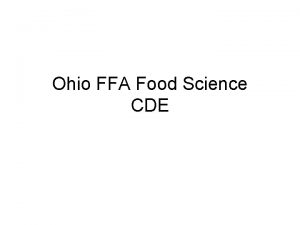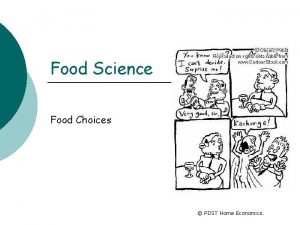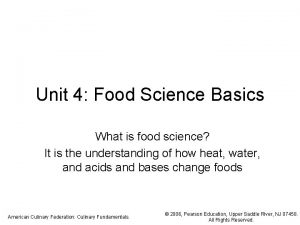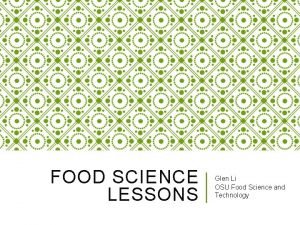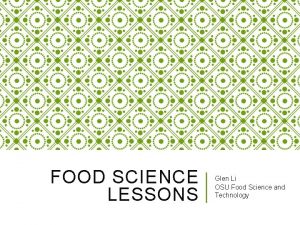Food Science Unit 1 Overview of Food Science

















- Slides: 17

Food Science : Unit 1 Overview of Food Science FFA Involvement in Food Science Determine meaning and importance of Food Science. World Food Needs

I. What is food science? Food science is the study of the food we eat, their makeup, and the processes used to make them more suitable for consumption. A. Food science includes : food chemistry, food physics, and food biology.

TERMS 1. Food chemistry is the study of substances that make up food and the nutrients found in food. 2. Food physics is the study of the physical characteristics of food. 3. Food biology focuses on the microbes in and on the foods we eat.

Why is food science important? II. Food science is important because: 1. It has helped us reduce food deterioration. 2. It has increase food preservation. 3. It has discovered new foods.

1. Reduce Food Deterioration is the natural breakdown of food products. Mold is an example of deterioration in food products.

3. Food science has led to the discovery of many new foods. As the world’s population grows, so does the need for food. New plants and animals, as well as new uses for the plants and animals already domesticated have led to the discovery of new foods. Domestication is the continual process of altering plants and animals so they become reliable parts of the food chain.

2. Preservation is the use of processing to help keep foods in a useful state for a longer period of time. Examples of preservation methods include refrigeration and chemical preservatives.

II. What activates in FFA involve Food Science? CDE’s ( Career Development Events) The Food Science Contest is a fairly new contest in Arkansas. There is not a District contest- compete at the state level automatically.

Cotter has been very successful in at this contest in the past.

American Farmers Feed the World America's farmers are the world's most productive. Today, ONE U. S. farmer produces food and fiber for 144 people. 2% of Americans are actual farmers or producers that grow the food the rest of the nation eats.

How has Food Science Changed the World?

How much do we spend on FOOD? Food is Most Affordable in the United States Americans spend 10% of their Annual Income on Food.

How do we Compare? Finland 16 France 18 New Zealand 20 Germany 21 Australia 21 United Kingdom 22 Italy 23 Spain 25 Japan 26 Israel 26 South Africa 28 Mexico 33 India 51

What do You think? ( don’t write down. ) How would you like spend half of your income on food? Example: If you made $300 a week, $150 would be spent on FOOD. Is this why Americans are the most obese country in the world?

4 major parts of the food industry. Production Manufacturing/ processing Distribution Marketing

Production: growing the food, or raising the source of food. Manufacturing: Converts raw material into the finished product. Distribution: Transportation and storage. Marketing: the selling of food, includes: Commercials, advertisements etc.

Food grown without chemical pesticides Organic Foods
 Unit 2 food food food
Unit 2 food food food An informal email to a friend
An informal email to a friend Unit 6 review questions
Unit 6 review questions Your favorite subject
Your favorite subject Sequence of food chain
Sequence of food chain Www.overview
Www.overview Maximo overview
Maximo overview Universal modeling language
Universal modeling language In uml is a connection among things
In uml is a connection among things Vertical overview
Vertical overview Figure 12-1 provides an overview of the lymphatic vessels
Figure 12-1 provides an overview of the lymphatic vessels Pulmonary circulation
Pulmonary circulation Texas public school finance overview
Texas public school finance overview Walmart
Walmart Stylistic overview of painting
Stylistic overview of painting Structured analysis and design
Structured analysis and design Spring framework overview
Spring framework overview Nagios tactical overview
Nagios tactical overview























